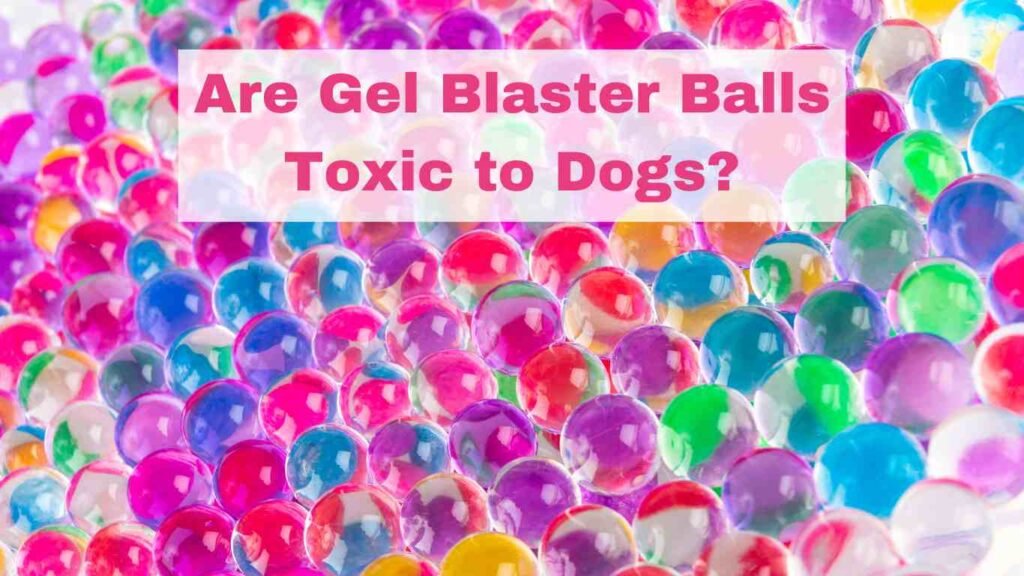“Are Gel Blaster Balls Toxic to Dogs?” While gel blaster balls are often associated with hours of harmless fun, an alarming 70% of pet owners are unaware of the potential hazards they pose to their furry friends. In a recent survey, it was revealed that cases of dog poisoning from gel blaster balls have prompted growing concerns among veterinarians and pet parents alike.
Although these colorful orbs are designed to dissolve and hold no intrinsic gel blaster balls toxicity, the risk lies in the possibility of ingestion, which can lead to serious health complications.
Understanding the intricate balance between pet safety and the enjoyment of modern outdoor activities has never been more crucial. When you unleash your dog into the backyard, you also need to be aware of the items they might encounter, including seemingly innocuous playthings like gel blaster balls. Let’s dive into what makes these objects a concern and how you can prevent a fun afternoon from turning into an emergency vet visit.
Are Gel Blaster Balls Toxic to Dogs?
Understanding Gel Blaster Balls and Your Pet’s Safety
As pet owners, it’s imperative to understand what gel blaster balls are made of and the potential risks they pose to pets. Contrary to some beliefs, gel blaster ammo toxicity is not a concern since these balls are designed to be non-toxic. However, the real danger lies not in their composition but in their size and expandability, which could lead to physical complications if pets ingest them. Let’s break down the actual make-up of these products and dispel some common myths.

What Are Gel Blaster Balls Made Of?
Gel blaster balls are crafted using a super-absorbent polymer. Upon coming into contact with water, they imbibe the liquid and transform into soft, gel-filled spheres. Not only is their gel blaster balls composition considered safe for environmental interaction due to their biodegradable nature, but it is also made to ensure a non-toxic experience for users.
Common Misconceptions About Gel Blaster Ammo Toxicity
One widespread misconception is that gel blaster ammo could be poisonous if ingested. The truth is, the ammunition is designed to be environmentally friendly and safe, posing minimal gel blaster ammo toxicity risks. Nevertheless, the question, “Are gel blaster balls toxic to dogs?” often arises because pets can experience health issues not from chemical toxicity, but from the potential of creating an obstruction within their digestive tracts. It’s crucial for pet owners to supervise their pets during recreation times to avoid these harmful scenarios.
[content-egg module=Amazon products=”us-B07ZN238CL” template=item_simple]The Accidental Ingestion Scenario: How Dogs May Encounter Gel Balls
It’s not uncommon for pets, particularly dogs, to unknowingly find themselves in risky situations within the comfort of their own homes. One such peril involves the gel blaster ball ingestion in dogs. Often used in games, these small, colorful spheres may attract a dog’s attention due to their resemblance to edible objects. Through accidental consumption, the gel balls may seem harmless, yet they pose a dangerous risk of leading to digestive complications.
Are gel balls harmful to dogs? While the answer to this question isn’t a straightforward ‘yes’ due to their non-toxic nature, the shape and absorbency of these gel balls present hazards if ingested. The expansion of the superabsorbent polymer material inside a dog’s stomach can create obstructions that are far from benign.
[content-egg module=Amazon products=”us-B0B8ZCSB8K” template=item_simple]As a pet owner, imagine your playful buddy sniffing around gel balls left after a backyard skirmish. Dogs’ curiosity and their propensity to nibble on or swallow objects can turn playtime into an emergency. Gel balls are particularly misleading for dogs; a gel blaster battle today could become a costly vet visit tomorrow.
- Supervision is Key: Never leave gel balls within paw’s reach after play.
- Mistaken for Treats: Their bouncy, bite-sized form can be irresistible to dogs.
- Immediate Action: If ingestion occurs, assess for any abnormal behavior and contact your vet.
We all want to ensure our furry friends remain safe in their playful environment. But when we introduce items like gel balls into the household, we inadvertently add elements of risk. By taking mindful steps, we can prevent the accidental consumption of gel blaster balls and protect our pets from unforeseen harm.

Are Gel Blaster Balls Toxic to Dogs?
Gel blaster balls are often considered a safe alternative for outdoor games and activities. But if you’re a pet owner, understanding the risks of gel blaster balls for pets is as crucial as knowing their intended use. Let’s delve into what the experts say about these playful pellets and the hidden dangers that could endanger your furry friend.
What the Experts Say About Gel Blaster Ball Composition
According to professionals in the field, gel blaster balls are crafted out of non-toxic, super-absorbent polymer materials. They expand when hydrated, transforming into soft, gel-like beads. Despite being marketed as safe for humans, the gel blaster balls toxicity question arises when these balls become potential hazards for pets, especially dogs. While they’re not poisonous, they’re certainly not meant for consumption.
How Non-Toxic Materials Can Still Pose Risks to Dogs
When a product is non-toxic, it doesn’t automatically warrant it as safe for all scenarios. If a dog were to ingest gel blaster balls, the consequences could range from minor discomfort to severe, life-threatening conditions. The potential for dog poisoning from gel blaster balls is, admittedly, low in terms of toxins. However, the physical impact they can have includes obstructing the digestive tract, causing choking, and leading to dehydration or possibly, surgical intervention.
The takeaway here is clear: even substances that aren’t chemically harmful can pose significant physical dangers. It’s crucial for you to be aware of these dangers, preventing your pets from any unwarranted play with these deceptively benign gel balls.
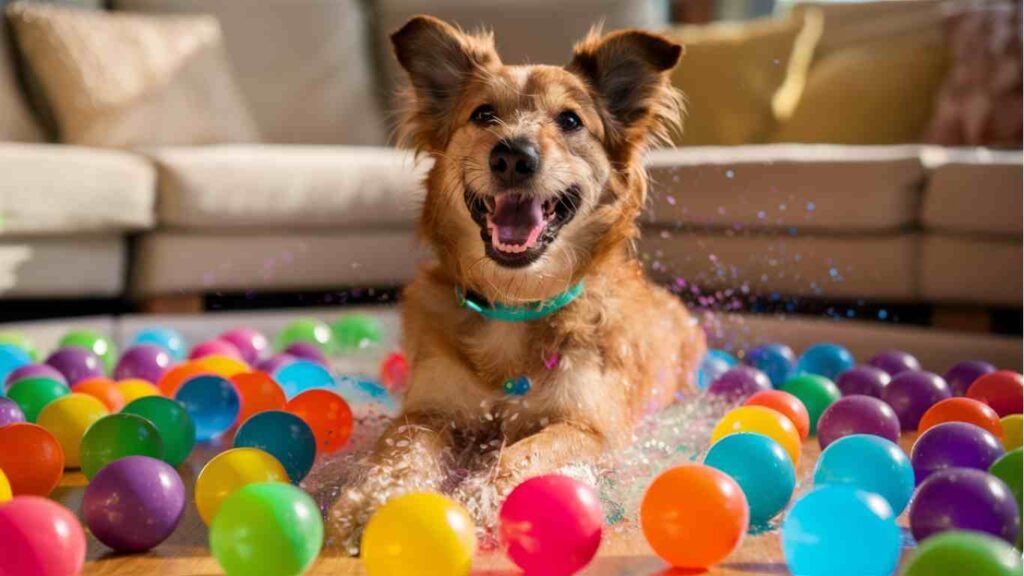
Anecdotal Evidence: Pet Owners’ Experiences with Gel Balls
Many pet owners have shared their gel ball ingestion stories, detailing the distressing instances when their furry companions accidentally consumed gel blaster balls. These narratives are not only alarming but are a clarion call for gel blaster ball safety for pets. Canines of smaller stature appear more susceptible to severe health issues due to the physical size of these gelatinous hazards. The enactment of precautionary measures cannot be overstated when it comes to your pets’ interaction with these innocuous-looking, yet potentially dangerous, items.
Pet owners’ experiences vary, but the common thread of urgency in seeking professional veterinary advice rings through each account. Immediate action is crucial, as it can mean the difference between a simple scare or a life-threatening emergency. To illustrate the gravity of these scenarios, let’s take a glance at the documented effects of ingestion in our four-legged friends:
| Size of Dog | Symptoms Observed | Outcome |
|---|---|---|
| Small Breeds | Vomiting, Lethargy, Constipation | Higher risk of blockage, potential surgery |
| Medium Breeds | Diarrhea, Abdominal Pain | Professional intervention often required |
| Large Breeds | Minimal to No Symptoms | May pass balls without incident, but monitoring advised |
Exploring the shared pet owners’ experiences, one can discern a pattern of symptoms such as lethargy and constipation, which underscore the disruptive nature of gel balls when they become foreign bodies in a pet’s digestive system. The lesson to be learned is straightforward: vigilant supervision and prompt veterinary care are imperative in maintaining the safety and health of our cherished pets.
Remember, no matter the size of your furry companion, the risk of gel ball ingestion should not be ignored. Always err on the side of caution and keep these malleable menaces out of paw’s reach.
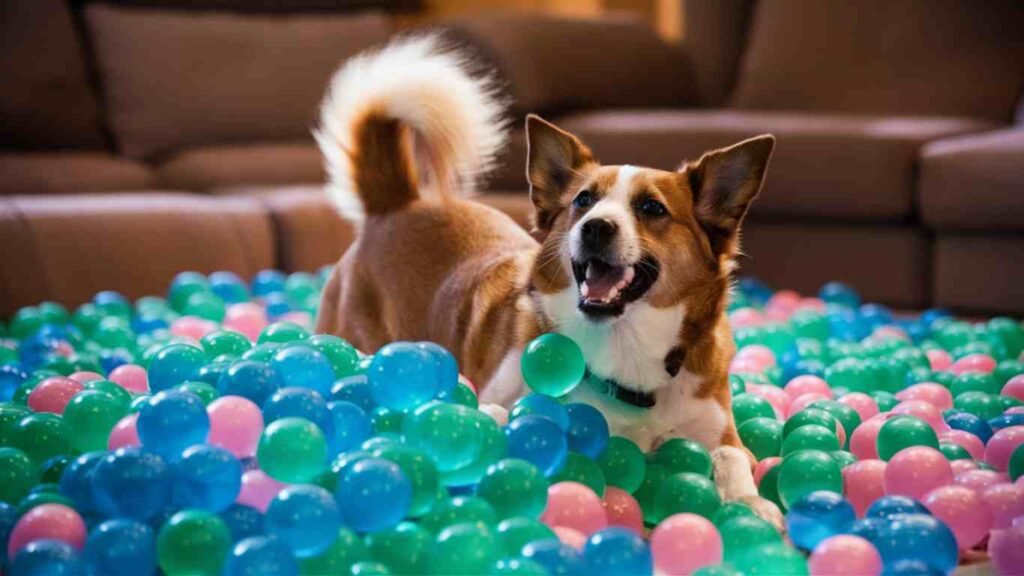
Reflect on these real-life anecdotes and consider how these insights can guide you in creating a safer environment for your pet. It’s a shared responsibility among the pet community to spread this knowledge for the wellbeing of all our companions.
Physiological Effects of Gel Ball Ingestion in Dogs
Dealing with the physiological effects of gel blaster ball ingestion in dogs requires a thorough understanding of the potential digestive system complications. When these super-absorbent objects become part of your pet’s diet, they could lead to severe health concerns that every pet owner should be prepared to address.
Potential for Intestinal Blockage and Choking Hazards
Unlike food that is easily digested and passed through your dog’s gastrointestinal tract, gel balls can swell inside the stomach, leading to dangerous blockages. These objects pose real risks of choking and intestinal obstruction, particularly in smaller breeds with narrower digestive pathways.
[content-egg module=Amazon products=”us-B0C4T4LCWM” template=item_simple]Recognizing the Signs of Gel Ball Digestive Issues in Pets
Recognizing gel ball digestive issues is crucial, and it can make the difference between a minor incident and a life-threatening situation. Symptoms to be aware of include:
- Vomiting
- Diarrhea
- Lack of appetite
- Weakness or lethargy
- Abdominal pain
- Dehydration
- Altered bowel movements
Being vigilant for these signs can help you act swiftly and seek veterinary care to mitigate the physiological effects of gel blaster balls.
| Symptom | Possible Cause | Immediate Action |
|---|---|---|
| Vomiting | Gel balls expanding within the stomach | Contact your veterinarian |
| Diarrhea | Intestinal irritation or partial blockage | Monitor hydration and see a vet |
| Lack of appetite | Discomfort or pain from internal swelling | Do not delay in seeking veterinary care |
| Weakness or lethargy | Dehydration or obstruction complications | Emergent visit to the veterinarian |
If you ever suspect your dog has swallowed gel blaster balls, remember that the symptoms could range from mild to severe. Focus on recognizing gel ball digestive issues and do not hesitate to contact your pet’s healthcare provider for advice and assistance.

Join Our GeoZoo Family
Subscribe to our Newsletter
Immediate Actions to Take if Your Dog Eats Gel Balls
If you find that your dog has ingested gel balls, such as Orbeez, it’s imperative to take immediate action. Stay calm, as your composed demeanor will help manage the situation more effectively. Begin by carefully observing your dog for any signs of distress or discomfort while you prepare to contact your veterinarian. Quick decision-making is key to ensuring the health and safety of your pet.
The following table outlines the critical steps to follow what to do if your dog eats Orbeez or similar gel balls:
| Step | Action | Details |
|---|---|---|
| 1 | Observe Your Dog | Look for any abnormal symptoms like vomiting, lethargy, or abdominal discomfort. |
| 2 | Contact Vet Immediately | Don’t wait for symptoms to worsen. |
| 3 | Do Not Induce Vomiting | This can cause more harm, follow the vet’s instructions instead. |
| 4 | Prepare for Transport | Keep your dog calm and comfortable for the trip to the veterinary clinic. |
| 5 | Follow Up Care | Stick to the treatment plan and monitor your dog closely post-vet visit. |
Remember, while gel balls like Orbeez are not inherently toxic, they can expand in your dog’s digestive system and potentially cause blockages or other health issues. Therefore, immediate action for dog gel ball ingestion is crucial for the well-being of your furry friend. Always keep these items out of your pet’s reach and stay vigilant to prevent accidental ingestion in the future.
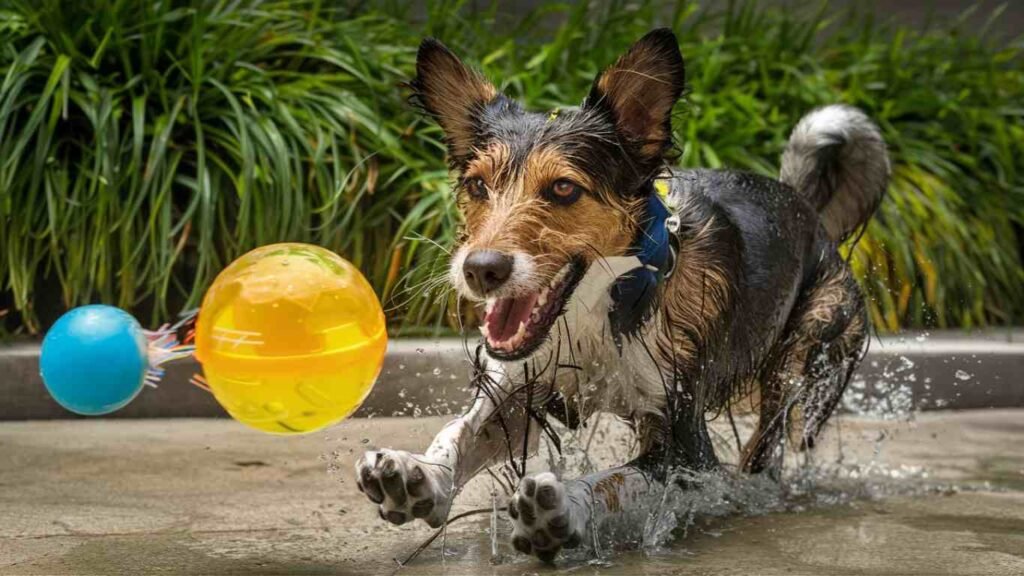
Preventative Measures: Keeping Gel Balls Away from Dogs
As pet owners, it’s your responsibility to ensure the environment is safe for your furry friends. Gel blaster balls, while great for outdoor fun, need to be managed with caution to prevent your dogs from encountering them. Stay proactive with gel blaster ball safety precautions to maintain a pet-friendly space.
Proper Storage and Disposal of Gel Blaster Balls
It all starts with how you store and dispose of these tempting, squishy orbs. To avoid any risks, preventative measures must include secure storage solutions. It’s imperative to keep gel blaster balls in a place where your dog cannot access them, perhaps in high shelves or locked cabinets. As for disposal, don’t leave any ball remnants around that could pique your pet’s curiosity. Biodegradable gel balls offer an eco-friendly disposal option — you can integrate them into soil, aiding water retention for plants.
[content-egg module=Amazon products=”us-B006HKA6II” template=item_simple]Best Practices for Using Gel Blasters Around Pets
When enjoying gel blaster activities, make sure your pets are elsewhere, under supervision, ensuring that their inherent curiosity doesn’t lead to accidental consumption. If you must use colored gel balls, opt for those free from harmful dyes, prioritizing your pet’s safety above all. Remember, taking these simple steps in the investment of storage and disposal of gel balls can create a harmonious environment for both your family’s enjoyment and your pet’s well-being.
By adhering to these best practices, you’re not only safeguarding your canine companions but also fostering a secure and pet-friendly hobby area. Keep these tips in mind, and enjoy the thrill of gel blasters without worry!
Gel Blaster Ball Safety: Tips for Pet Owners
As a responsible pet owner, it’s essential to be aware of the potential hazards posed by gel blaster balls in your home environment. Implementing practical gel blaster ball safety tips can safeguard your pets from accidents and ensure their safety. Here’s how you can keep your furry friend safe without sacrificing the fun of your recreational activities.

Firstly, ensure that all gel blaster balls are stored in a secure location, beyond the reach of your pets. Just as you would with any other potential hazard, always use closed containers—particularly for those gel balls used for decorative purposes. This will prevent your pets from mistaking them for snacks. Moreover, it is vital to supervise any play that involves gel blasters, keeping a close eye on your pets during such activities.
- Provide your dog with engaging alternatives like chew toys to distract them from the gel balls.
- Train your pets to stay away from gel blasters and the ammo used.
- Regularly inspect areas where gel blasters are used to ensure no stray balls are left behind.
With these measures, you’re not only implementing gel blaster ball safety for pets, but also promoting a pet-friendly environment at home. Take a look at the table below to quickly reference our recommended safety actions:
| Action | Benefit | Tip |
|---|---|---|
| Secure Storage | Prevents accidental ingestion | Use child-proof and pet-proof containers for storing gel balls |
| Close Supervision | Immediate response in case of mishap | Keep play areas within view and regularly check on your pet |
| Provide Alternatives | Reduces the attraction of gel balls | Invest in quality chew toys and engaging puzzles |
| Training | Teaches pets to avoid gel balls | Use positive reinforcement techniques to encourage good behavior |
Remember, your vigilance and proactive stance on gel blaster ball safety tips are the best defense against potential risks for your pets. By keeping your pets’ environment safe and providing appropriate supervision, you can enjoy the fun of gel blasters without worry.

Veterinary Advice: When to Seek Professional Help
As a pet owner, your dog’s safety is always a priority, and understanding when to seek professional help for gel ball ingestion is vital. If your playful companion has had an unfortunate encounter with gel blaster balls, being aware of emergency symptoms is critical for their health.
Understanding Symptoms and When They Are an Emergency
Identifying the right moment to call for veterinary advice can be the difference between a quick recovery and a medical emergency. Watch closely for signs that require immediate attention, such as excessive drooling, difficulty breathing, or sudden changes in behavior. Below is a guide to help you recognize these alarming symptoms:
| Symptoms | Actions to Take |
|---|---|
| Constant Thirst & Vomiting | Contact your veterinarian without delay |
| Decrease in Appetite | Monitor closely and report to your vet |
| Swollen Belly | Seek emergency veterinary care |
| Lethargy or Unresponsiveness | Rush to an animal hospital as it may be critical |
| Difficulty Defecating | Call your vet for immediate advice |
Long-Term Monitoring After Ingestion of Gel Balls
Some complications from ingesting gel balls may not be immediate, and this is where long-term monitoring becomes essential. Post-ingestion issues might not become apparent right after the incident. Schedule regular veterinary check-ups to ensure that your furry friend has not developed any delayed complications from the gel ball ingestion.
If you’ve had a scare and your dog ingested gel balls, you’re not alone. Don’t hesitate to reach out for veterinary advice. Remember, early intervention can significantly reduce the risk of health ramifications, and your vet’s expertise will guide you through the proper steps to ensure the safety and well-being of your dog.
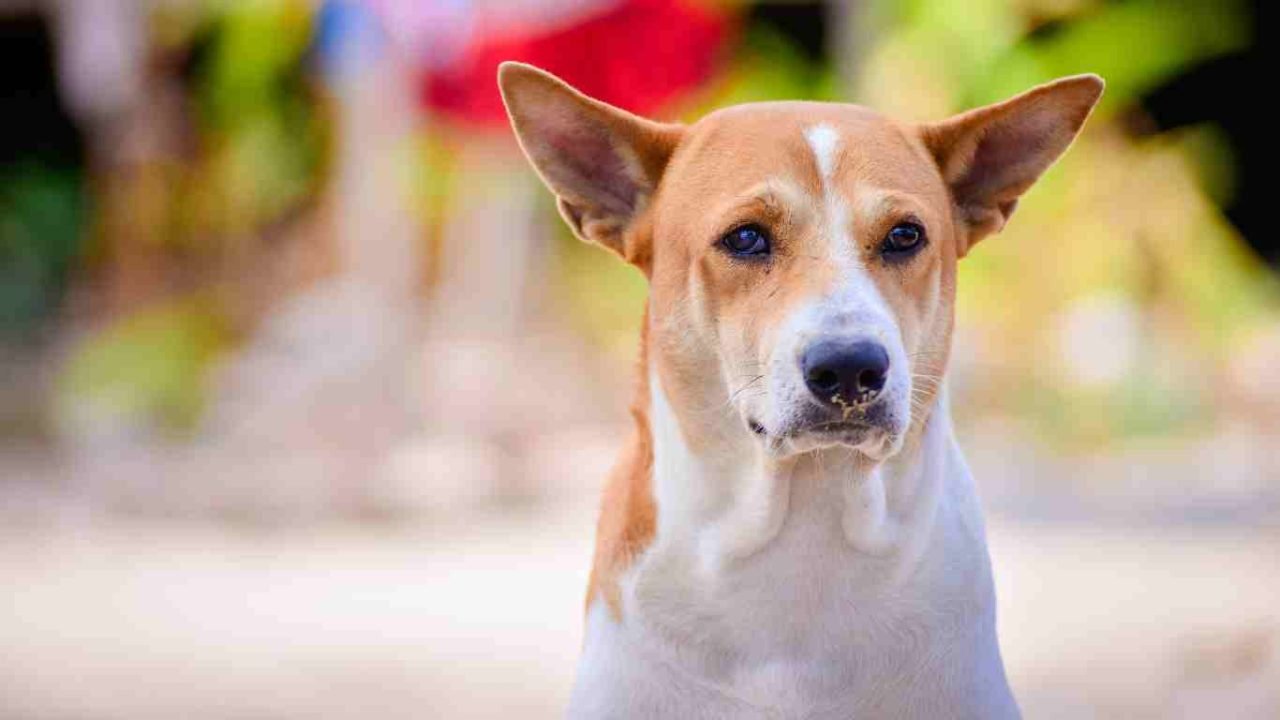
Join Our GeoZoo Family
Subscribe to our Newsletter
brief: Stressing the Importance of Caution and Care
As we wrap up our discussion, it’s evident that gel blaster ball caution and care are of utmost importance for ensuring the safety of our furry friends. Pet owners need to bear in mind that despite their non-toxicity, gel blaster balls can lead to significant physical problems for pets, particularly in canine companions who may find them irresistible. You hold the key to preventing pet ingestion of gel balls, and it begins with being proactive and attentive.
While engaging in leisure activities that involve these colorful polymer beads, remember to exercise the same level of vigilance with your pets as you would with a young child. Keep an eye out, store gel blasters and their ammunition safely, and educate your family about the potential risks involved. In the unfortunate event that your dog does partake in an unplanned gel ball feast, your quick thinking and fast action in seeking veterinary advice can make all the difference. A delay might escalate into an emergency that requires complicated interventions.
Stories shared by fellow pet owners and the data presented throughout this article reiterate an overriding message: safety first. By remaining diligent and aware of the hazards, you can ensure that your pet’s interaction with gel blaster balls never ends in a trip to the vet. Prioritize your pet’s well-being by practicing and promoting safety measures, and enjoy the peace of mind that comes from knowing you are protecting your cherished companion.
FAQ
Are gel blaster balls toxic to dogs?
No, gel blaster balls are not toxic since they are made of a non-toxic super-absorbent polymer. However, they can pose other risks to dogs such as digestive blockages and choking if ingested.
What are gel blaster balls made of?
Gel blaster balls are composed of water-absorbent polymers that expand and turn gel-like upon hydration. They are biodegradable and eco-friendly.
Can the accidental consumption of gel balls be harmful to dogs?
Yes, accidental ingestion can be harmful. While the material itself may not be toxic, the expanded balls can cause internal blockages that might require veterinary intervention.
What should I do if my dog eats gel balls?
If your dog eats gel balls, monitor them closely for any signs of distress, and contact your veterinarian immediately for advice and possible treatment.
What steps can I take to prevent my dog from ingesting gel blaster balls?
To prevent ingestion, store gel blaster balls safely out of reach, supervise your pet closely during play, and ensure no gel balls are left in the environment after use. Consider avoiding colorful gel balls, which might attract your pet.
What are the signs of a dog having digestive issues from gel balls?
Signs of digestive issues from ingesting gel balls include vomiting, diarrhea, decreased appetite, lethargy, and signs of distress. Seek veterinary assistance if you notice any of these symptoms.
How can I keep my pet safe around gel blasters and their ammo?
Keep gel blaster ammo out of reach, clean up thoroughly after play, and avoid using gel blasters in the vicinity of pets. Provide your pets with alternative toys to keep their attention away from gel blasters and balls.
Can a dog pass gel balls naturally after ingesting them?
While some dogs may pass the gel balls naturally, there is a risk of blockages, especially in small breeds. Always consult a veterinarian if you suspect your dog has ingested gel balls.
When should I seek professional help if I suspect my dog has ingested gel balls?
Seek professional help immediately if you suspect ingestion, even if your pet is not showing symptoms yet. Quick veterinary attention is crucial for preventing more serious health problems or potential surgery due to blockages.
Are there any long-term effects of gel ball ingestion in dogs?
The long-term effects can vary depending on the severity of the ingestion and any resulting blockages. Monitoring by a veterinarian after ingestion is essential to address any lingering issues that may develop.

